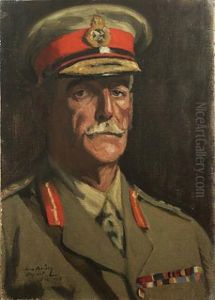James Mcbey Paintings
James McBey was a British artist and etcher, born in Newburgh, Aberdeenshire, Scotland, on December 23, 1883. Despite having limited formal education in art, McBey is remembered as a self-taught artist who rose to prominence for his exceptional etchings and watercolors. He initially worked as a bank clerk, teaching himself etching and drawing during his spare time. His early work was greatly influenced by the style of Rembrandt, and he often used the Dutch master's techniques to develop his unique style.
McBey's talent was recognized early in his career, leading to his first exhibition in 1908. His work was characterized by its detailed depiction of landscapes, scenes of daily life, and portraits, capturing the essence of his subjects with remarkable sensitivity and skill. In 1911, he decided to pursue art full-time, a decision that marked the beginning of a successful and prolific career.
During World War I, McBey served in the British Army, and his experiences influenced his work significantly. He was appointed an Official War Artist in 1917, tasked with documenting the conflict. His war-time etchings and watercolors are notable for their realism and emotional depth, offering a poignant glimpse into the experiences of soldiers and the landscapes of war.
After the war, McBey traveled extensively, drawing inspiration from his journeys to North Africa, Europe, and the United States. His travels influenced his work, introducing new themes and subjects. He developed a particular fascination with the landscapes and people of Morocco, which became a recurring motif in his later work.
James McBey's contributions to art were recognized with his election to the Royal Society of Painter-Etchers and Engravers in 1920. His work continued to evolve, and he enjoyed considerable success both in Britain and internationally. McBey was known for his mastery of light and shadow, his skillful etching technique, and his ability to convey the mood and atmosphere of his subjects.
He married Marguerite Loeb in 1931, and they lived in both England and Morocco. McBey's later years were marked by continued artistic exploration and production. He passed away on December 1, 1959, in Tangier, Morocco, leaving behind a legacy as one of the foremost British printmakers and watercolorists of his time. His work is held in high regard and can be found in major museums and collections around the world.
